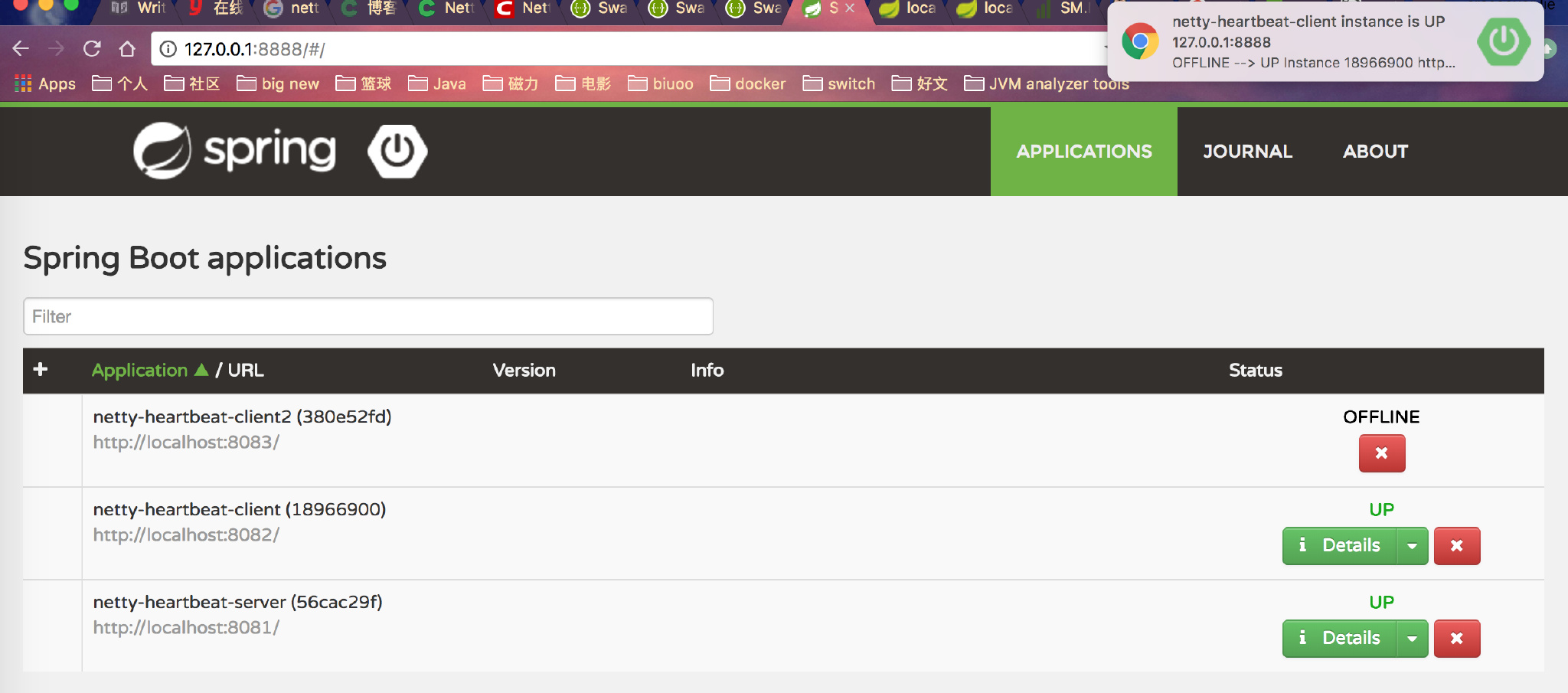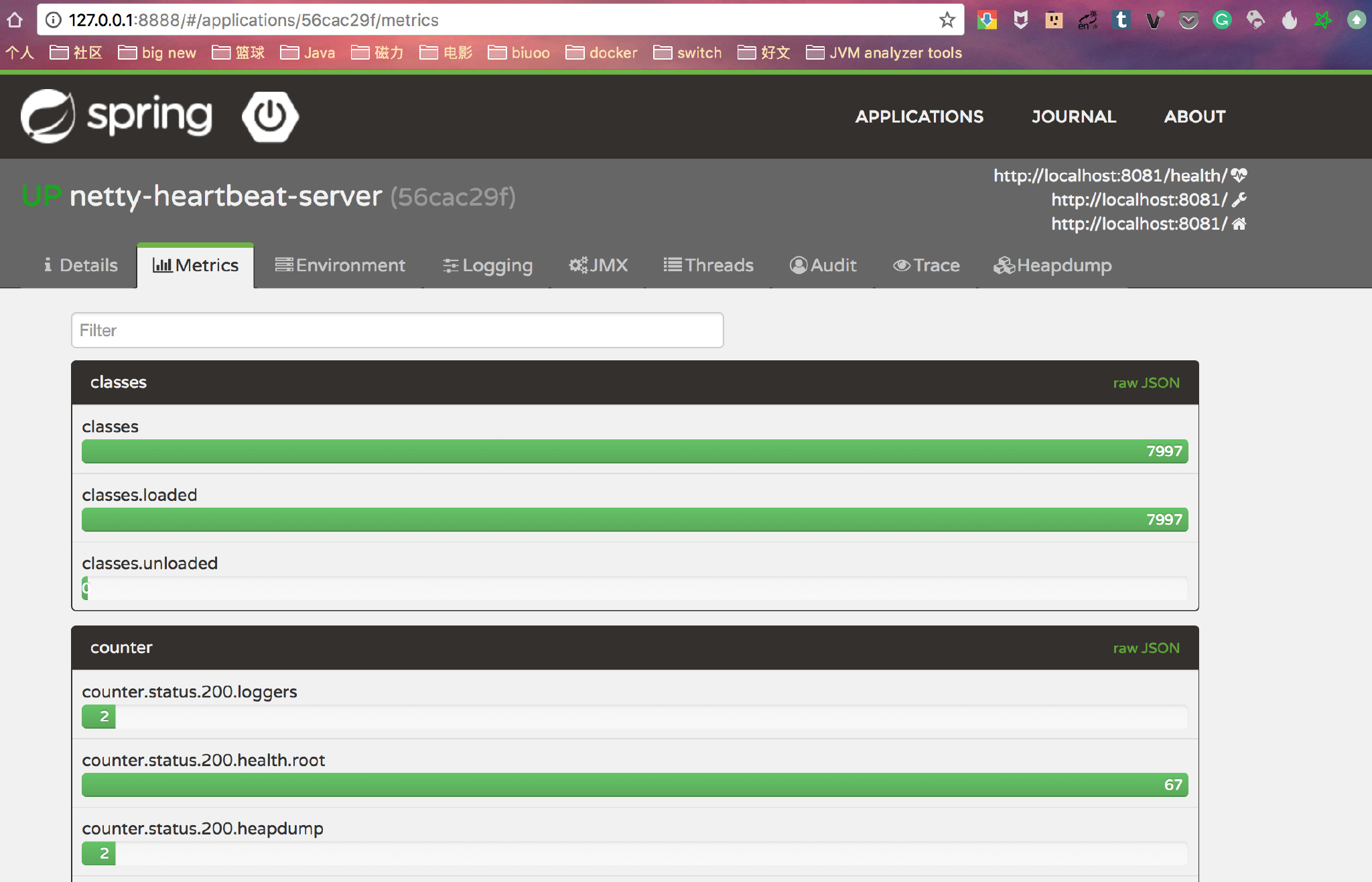前言 Netty 是一个高性能的 NIO 网络框架,本文基于 SpringBoot 以常见的心跳机制来认识 Netty。
最终能达到的效果:
客户端每隔 N 秒检测是否需要发送心跳。
服务端也每隔 N 秒检测是否需要发送心跳。
服务端可以主动 push 消息到客户端。
基于 SpringBoot 监控,可以查看实时连接以及各种应用信息。
效果如下:
IdleStateHandler Netty 可以使用 IdleStateHandler 来实现连接管理,当连接空闲时间太长(没有发送、接收消息)时则会触发一个事件,我们便可在该事件中实现心跳机制。
客户端心跳 当客户端空闲了 N 秒没有给服务端发送消息时会自动发送一个心跳来维持连接。
核心代码代码如下:
1 2 3 4 5 6 7 8 9 10 11 12 13 14 15 16 17 18 19 20 21 22 23 24 25 26 27 28 29 30 31 32 33 34 public class EchoClientHandle extends SimpleChannelInboundHandler <ByteBuf> {private final static Logger LOGGER = LoggerFactory.getLogger(EchoClientHandle.class);@Override public void userEventTriggered (ChannelHandlerContext ctx, Object evt) throws Exception {if (evt instanceof IdleStateEvent){IdleStateEvent idleStateEvent = (IdleStateEvent) evt ;if (idleStateEvent.state() == IdleState.WRITER_IDLE){"已经 10 秒没有发送信息!" );CustomProtocol heartBeat = SpringBeanFactory.getBean("heartBeat" , CustomProtocol.class);super .userEventTriggered(ctx, evt);@Override protected void channelRead0 (ChannelHandlerContext channelHandlerContext, ByteBuf in) throws Exception {"客户端收到消息={}" ,in.toString(CharsetUtil.UTF_8)) ;
实现非常简单,只需要在事件回调中发送一个消息即可。
由于整合了 SpringBoot ,所以发送的心跳信息是一个单例的 Bean。
1 2 3 4 5 6 7 8 9 10 11 12 @Configuration public class HeartBeatConfig {@Value("${channel.id}") private long id ;@Bean(value = "heartBeat") public CustomProtocol heartBeat () {return new CustomProtocol (id,"ping" ) ;
这里涉及到了自定义协议的内容,请继续查看下文。
当然少不了启动引导:
1 2 3 4 5 6 7 8 9 10 11 12 13 14 15 16 17 18 19 20 21 22 23 24 25 26 27 28 29 30 31 32 33 34 35 36 37 38 39 40 41 42 43 44 @Component public class HeartbeatClient {private final static Logger LOGGER = LoggerFactory.getLogger(HeartbeatClient.class);private EventLoopGroup group = new NioEventLoopGroup ();@Value("${netty.server.port}") private int nettyPort;@Value("${netty.server.host}") private String host;private SocketChannel channel;@PostConstruct public void start () throws InterruptedException {Bootstrap bootstrap = new Bootstrap ();new CustomerHandleInitializer ())ChannelFuture future = bootstrap.connect(host, nettyPort).sync();if (future.isSuccess()) {"启动 Netty 成功" );public class CustomerHandleInitializer extends ChannelInitializer <Channel> {@Override protected void initChannel (Channel ch) throws Exception {new IdleStateHandler (0 , 10 , 0 ))new HeartbeatEncode ())new EchoClientHandle ())
所以当应用启动每隔 10 秒会检测是否发送过消息,不然就会发送心跳信息。
服务端心跳 服务器端的心跳其实也是类似,也需要在 ChannelPipeline 中添加一个 IdleStateHandler 。
1 2 3 4 5 6 7 8 9 10 11 12 13 14 15 16 17 18 19 20 21 22 23 24 25 26 27 28 29 30 31 32 33 34 35 36 37 38 39 40 41 42 43 44 public class HeartBeatSimpleHandle extends SimpleChannelInboundHandler <CustomProtocol> {private final static Logger LOGGER = LoggerFactory.getLogger(HeartBeatSimpleHandle.class);private static final ByteBuf HEART_BEAT = Unpooled.unreleasableBuffer(Unpooled.copiedBuffer(new CustomProtocol (123456L ,"pong" ).toString(),CharsetUtil.UTF_8));@Override public void channelInactive (ChannelHandlerContext ctx) throws Exception {@Override public void userEventTriggered (ChannelHandlerContext ctx, Object evt) throws Exception {if (evt instanceof IdleStateEvent){IdleStateEvent idleStateEvent = (IdleStateEvent) evt ;if (idleStateEvent.state() == IdleState.READER_IDLE){"已经5秒没有收到信息!" );super .userEventTriggered(ctx, evt);@Override protected void channelRead0 (ChannelHandlerContext ctx, CustomProtocol customProtocol) throws Exception {"收到customProtocol={}" , customProtocol);
这里有点需要注意 :
当有多个客户端连上来时,服务端需要区分开,不然响应消息就会发生混乱。
所以每当有个连接上来的时候,我们都将当前的 Channel 与连上的客户端 ID 进行关联(因此每个连上的客户端 ID 都必须唯一 )。
这里采用了一个 Map 来保存这个关系,并且在断开连接时自动取消这个关联。
1 2 3 4 5 6 7 8 9 10 11 12 13 14 15 16 17 18 19 public class NettySocketHolder {private static final Map<Long, NioSocketChannel> MAP = new ConcurrentHashMap <>(16 );public static void put (Long id, NioSocketChannel socketChannel) {public static NioSocketChannel get (Long id) {return MAP.get(id);public static Map<Long, NioSocketChannel> getMAP () {return MAP;public static void remove (NioSocketChannel nioSocketChannel) {
启动引导程序:
1 2 3 4 5 6 7 8 9 10 11 12 13 14 15 16 17 18 19 20 21 22 23 24 25 26 27 28 29 30 31 32 33 34 35 36 37 38 39 40 41 42 43 44 45 46 47 48 49 50 51 52 53 54 55 56 57 58 59 Componentpublic class HeartBeatServer {private final static Logger LOGGER = LoggerFactory.getLogger(HeartBeatServer.class);private EventLoopGroup boss = new NioEventLoopGroup ();private EventLoopGroup work = new NioEventLoopGroup ();@Value("${netty.server.port}") private int nettyPort;@PostConstruct public void start () throws InterruptedException {ServerBootstrap bootstrap = new ServerBootstrap ()new InetSocketAddress (nettyPort))true )new HeartbeatInitializer ());ChannelFuture future = bootstrap.bind().sync();if (future.isSuccess()) {"启动 Netty 成功" );@PreDestroy public void destroy () {"关闭 Netty 成功" );public class HeartbeatInitializer extends ChannelInitializer <Channel> {@Override protected void initChannel (Channel ch) throws Exception {new IdleStateHandler (5 , 0 , 0 ))new HeartbeatDecoder ())new HeartBeatSimpleHandle ());
也是同样将IdleStateHandler 添加到 ChannelPipeline 中,也会有一个定时任务,每5秒校验一次是否有收到消息,否则就主动发送一次请求。
因为测试是有两个客户端连上所以有两个日志。
自定义协议 上文其实都看到了:服务端与客户端采用的是自定义的 POJO 进行通讯的。
所以需要在客户端进行编码,服务端进行解码,也都只需要各自实现一个编解码器即可。
CustomProtocol:
1 2 3 4 5 6 7 public class CustomProtocol implements Serializable {private static final long serialVersionUID = 4671171056588401542L ;private long id ;private String content ;
客户端的编码器:
1 2 3 4 5 6 7 8 9 public class HeartbeatEncode extends MessageToByteEncoder <CustomProtocol> {@Override protected void encode (ChannelHandlerContext ctx, CustomProtocol msg, ByteBuf out) throws Exception {
也就是说消息的前八个字节为 header,剩余的全是 content。
服务端的解码器:
1 2 3 4 5 6 7 8 9 10 11 12 13 14 15 16 public class HeartbeatDecoder extends ByteToMessageDecoder {@Override protected void decode (ChannelHandlerContext ctx, ByteBuf in, List<Object> out) throws Exception {long id = in.readLong() ;byte [] bytes = new byte [in.readableBytes()] ;String content = new String (bytes) ;CustomProtocol customProtocol = new CustomProtocol () ;
只需要按照刚才的规则进行解码即可。
实现原理 其实联想到 IdleStateHandler 的功能,自然也能想到它实现的原理:
应该会存在一个定时任务的线程去处理这些消息。
来看看它的源码:
首先是构造函数:
1 2 3 4 5 6 7 8 public IdleStateHandler ( int readerIdleTimeSeconds, int writerIdleTimeSeconds, int allIdleTimeSeconds) this (readerIdleTimeSeconds, writerIdleTimeSeconds, allIdleTimeSeconds,
其实就是初始化了几个数据:
readerIdleTimeSeconds:一段时间内没有数据读取
writerIdleTimeSeconds:一段时间内没有数据发送
allIdleTimeSeconds:以上两种满足其中一个即可
因为 IdleStateHandler 也是一种 ChannelHandler,所以会在 channelActive 中初始化任务:
1 2 3 4 5 6 7 8 9 10 11 12 13 14 15 16 17 18 19 20 21 22 23 24 25 26 27 28 29 30 31 32 33 34 35 @Override public void channelActive (ChannelHandlerContext ctx) throws Exception {super .channelActive(ctx);private void initialize (ChannelHandlerContext ctx) {switch (state) {case 1 :case 2 :return ;1 ;if (readerIdleTimeNanos > 0 ) {new ReaderIdleTimeoutTask (ctx),if (writerIdleTimeNanos > 0 ) {new WriterIdleTimeoutTask (ctx),if (allIdleTimeNanos > 0 ) {new AllIdleTimeoutTask (ctx),
也就是会按照我们给定的时间初始化出定时任务。
接着在任务真正执行时进行判断:
1 2 3 4 5 6 7 8 9 10 11 12 13 14 15 16 17 18 19 20 21 22 23 24 25 26 27 28 29 30 31 32 private final class ReaderIdleTimeoutTask extends AbstractIdleTask {super (ctx);@Override protected void run (ChannelHandlerContext ctx) {long nextDelay = readerIdleTimeNanos;if (!reading) {if (nextDelay <= 0 ) {this , readerIdleTimeNanos, TimeUnit.NANOSECONDS);boolean first = firstReaderIdleEvent;false ;try {IdleStateEvent event = newIdleStateEvent(IdleState.READER_IDLE, first);catch (Throwable t) {else {this , nextDelay, TimeUnit.NANOSECONDS);
如果满足条件则会生成一个 IdleStateEvent 事件。
SpringBoot 监控 由于整合了 SpringBoot 之后不但可以利用 Spring 帮我们管理对象,也可以利用它来做应用监控。
actuator 监控 当我们为引入了:
1 2 3 4 <dependency > <groupId > org.springframework.boot</groupId > <artifactId > spring-boot-starter-actuator</artifactId > </dependency >
就开启了 SpringBoot 的 actuator 监控功能,他可以暴露出很多监控端点供我们使用。
如一些应用中的一些统计数据:
存在的 Beans:
更多信息请查看:https://docs.spring.io/spring-boot/docs/current/reference/html/production-ready-endpoints.html
但是如果我想监控现在我的服务端有多少客户端连上来了,分别的 ID 是多少?
其实就是实时查看我内部定义的那个关联关系的 Map。
这就需要暴露自定义端点了。
自定义端点 暴露的方式也很简单:
继承 AbstractEndpoint 并复写其中的 invoke 函数:
1 2 3 4 5 6 7 8 9 10 11 12 13 14 15 16 17 public class CustomEndpoint extends AbstractEndpoint <Map<Long,NioSocketChannel>> {public CustomEndpoint (String id) {super (id, false );@Override public Map<Long, NioSocketChannel> invoke () {return NettySocketHolder.getMAP();
其实就是返回了 Map 中的数据。
再配置一个该类型的 Bean 即可:
1 2 3 4 5 6 7 8 9 10 11 12 13 @Configuration public class EndPointConfig {@Value("${monitor.channel.map.key}") private String channelMap;@Bean public CustomEndpoint buildEndPoint () {CustomEndpoint customEndpoint = new CustomEndpoint (channelMap) ;return customEndpoint ;
这样我们就可以通过配置文件中的 monitor.channel.map.key 来访问了:
一个客户端连接时:
两个客户端连接时:
整合 SBA 这样其实监控功能已经可以满足了,但能不能展示的更美观、并且多个应用也可以方便查看呢?
有这样的开源工具帮我们做到了:
https://github.com/codecentric/spring-boot-admin
简单来说我们可以利用该工具将 actuator 暴露出来的接口可视化并聚合的展示在页面中:
接入也很简单,首先需要引入依赖:
1 2 3 4 5 <dependency > <groupId > de.codecentric</groupId > <artifactId > spring-boot-admin-starter-client</artifactId > </dependency >
并在配置文件中加入:
1 2 3 4 management.security.enabled =false spring.boot.admin.url =http://127.0.0.1:8888
在启动应用之前先讲 SpringBootAdmin 部署好:
这个应用就是一个纯粹的 SpringBoot ,只需要在主函数上加入 @EnableAdminServer 注解。
1 2 3 4 5 6 7 8 9 10 @SpringBootApplication @Configuration @EnableAutoConfiguration @EnableAdminServer public class AdminApplication {public static void main (String[] args) {
引入:
1 2 3 4 5 6 7 8 9 10 <dependency > <groupId > de.codecentric</groupId > <artifactId > spring-boot-admin-starter-server</artifactId > <version > 1.5.7</version > </dependency > <dependency > <groupId > de.codecentric</groupId > <artifactId > spring-boot-admin-server-ui</artifactId > <version > 1.5.6</version > </dependency >
之后直接启动就行了。
这样我们在 SpringBootAdmin 的页面中就可以查看很多应用信息了。
更多内容请参考官方指南:
http://codecentric.github.io/spring-boot-admin/1.5.6/
自定义监控数据 其实我们完全可以借助 actuator 以及这个可视化页面帮我们监控一些简单的度量信息。
比如我在客户端和服务端中写了两个 Rest 接口用于向对方发送消息。
只是想要记录分别发送了多少次:
客户端:
1 2 3 4 5 6 7 8 9 10 11 12 13 14 15 16 17 18 19 20 21 22 23 24 25 26 27 28 29 30 31 32 33 34 35 36 @Controller @RequestMapping("/") public class IndexController {@Autowired private CounterService counterService;@Autowired private HeartbeatClient heartbeatClient ;@ApiOperation("客户端发送消息") @RequestMapping("sendMsg") @ResponseBody public BaseResponse<SendMsgResVO> sendMsg (@RequestBody SendMsgReqVO sendMsgReqVO) {new BaseResponse ();new CustomProtocol (sendMsgReqVO.getId(),sendMsgReqVO.getMsg())) ;SendMsgResVO sendMsgResVO = new SendMsgResVO () ;"OK" ) ;return res ;
只要我们引入了 actuator 的包,那就可以直接注入 counterService ,利用它来帮我们记录数据。
当我们调用该接口时:
在监控页面中可以查询刚才的调用情况:
服务端主动 push 消息也是类似,只是需要在发送时候根据客户端的 ID 查询到具体的 Channel 发送:
总结 以上就是一个简单 Netty 心跳示例,并演示了 SpringBoot 的监控,之后会继续更新 Netty 相关内容,欢迎关注及指正。
本文所有代码:
https://github.com/crossoverJie/netty-action
号外 最近在总结一些 Java 相关的知识点,感兴趣的朋友可以一起维护。
地址: https://github.com/crossoverJie/Java-Interview















